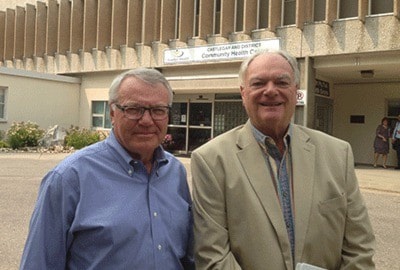From the Castlegar and District Health Centre, Interior Health Authority Chief Executive Officer Rob Halpenny touched base recently with local media.
The Castlegar stop, made by Halpenny along with IHA Board Chair Norman Embree was part of a sweep to each healthcare facility across the region.
Halpenny made himself available for a series of questions on local healthcare concerns at each of the stops as he also bolstered connections with local IHA personnel.
As far as this community is concerned, a quick poll of the Castlegar News office produced three issues that are likely shared in most areas of the province.
The first topic broached was that of wait times for medical procedures. The CEO assured that high priority is given where the situation is most acute.
“For example, the wait list for open heart surgery is very low,” said Halpenny. “Because that’s a life- threatening situation. Where we struggle is the elective procedures where people can wait. This is one of the issues that we have. Our wait lists in Kootenay Boundary -we monitor them compared to the rest of the health authority and I think they’re consistent. So, waiting for your cataract (operation) is different than waiting for your open heart surgery.”
The matter of transfer times between hospitals was a concern raised in the initial poll for this effort, something the CEO tackled next.
“We work really closely with the ambulance service,” Halpenny began. “I think it’s important to understand that the ambulance is not a service that we have control over; it’s a separate entity under the provincial health services authority.” He drew a parallel with the first point raised.
“It’s the same thing, those situations where there’s high acuity… our transfer time is really good,” he explained. “If you have a patient who’s been in a car accident, and/or needing cardiac service or something like that, those folks get priority. Because of resources, human resources as well, someone is being transferred from one hospital to the next, for example from Trail to Nakusp, and they need the transportation. Unfortunately, those people will have to wait until there’s available resources. It’s something we’re working on constantly,” Halpenny assured. “I know if I were a patient I’d want the service as expeditiously as possible.”
The third issue identified in the informal office poll related to a real life experience of a relative, who had apparently suffered post operative infection at WKRH-something he had to be taken to Vancouver to have dealt with.
“That’s pretty unusual,” said Halpenny. “When I look at the infection rates, and we look across all our sites, I certainly don’t see anything that’s unusual in Trail. That would be unusual, that a person would have to go to Vancouver. It would probably suggest it was the type of infection that was resistant to therapy… and very often certain patients are compromised in their ability to fight infection.”
The CEO stated, in closing, that in looking across the various IHA sites he sees no specific location that has particularly high infection rates.
